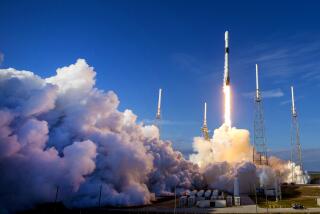SpaceX turned to fast-igniting fuel for its capsule escape system. That could be part of the accident probe
- Share via
During the Apollo era, NASA astronauts relied on a rocket tower at the top of the capsule to pull them safely away in case of an emergency. If it wasn’t used, the tower was jettisoned after the Saturn V rocket had reached about 295,000 feet.
But when SpaceX and Boeing Co. set out to build a new capsule, NASA decided to maintain the escape function all the way to orbit. In SpaceX’s case, that means building thrusters into the sides of its Crew Dragon — a move that also simplifies the number of staging events. Those SuperDraco thrusters are powered by monomethylhydrazine and nitrogen tetroxide — propellants that, when combined, immediately ignite.
The combination of those propellants may be scrutinized as part of the investigation into an accident Saturday during a “static fire” test of a Crew Dragon’s SuperDraco engines in Florida. The “anomaly,” as SpaceX and NASA described it, sent up a plume of orange smoke — a sign, experts say, that could indicate nitrogen tetroxide was involved.
Neither SpaceX nor NASA would say whether the Crew Dragon test capsule — the same one that flew on a first, uncrewed test flight to the International Space Station in March — was lost in the explosion. Hawthorne-based SpaceX said no one was injured and that teams from the company were investigating and “working closely with our NASA partners.”
The very purpose of the SuperDraco engines — almost instantly spiriting away astronauts from the rocket during an emergency — explains the decision to use those so-called hypergolic propellants, said David Barnhart, director of USC’s space engineering research center.
“You don’t have to wait for an igniter,” he said. “You get instant thrust.”
During a 2015 test of the capsule’s abort system, the Crew Dragon’s eight SuperDraco engines fired up, and each instantly produced about 15,000 pounds of thrust, according to a NASA statement at the time.
Hypergolic propellants have been used in other spacecraft, dating back to the engine that powered the upper section of the Apollo lunar module. The space shuttle used them in its orbital maneuvering system, allowing the shuttle to move through space.
Satellites also use them to maneuver, said Ray Lugo, director of the University of Central Florida’s Florida Space Institute and former director of the NASA Glenn Research Center in Cleveland.
The propellants can be easily stored, unlike liquid oxygen, which needs to stay cold, said Phil Westmoreland, a professor in the department of chemical and biomolecular engineering at North Carolina State University.
And unlike a solid rocket booster, which simply burns down once it is ignited, hypergolic propellants can be controlled through opening and closing valves in the rocket engine chamber. That helps throttle thrust, depending on how much is needed, Barnhart said.
But hypergolic fuels must be handled carefully, Westmoreland said. When researching how to improve the safety of the materials, he said, his group would isolate the two different types of propellants on two separate sides of the working area.
“These react together,” he said. “That’s why you have to be extra careful.”
SpaceX said it had been conducting a series of engine tests Saturday on the Crew Dragon capsule. While initial tests were successfully completed, the final one “resulted in an anomaly on the test stand,” SpaceX said in a statement at the time.
More to Read
Inside the business of entertainment
The Wide Shot brings you news, analysis and insights on everything from streaming wars to production — and what it all means for the future.
You may occasionally receive promotional content from the Los Angeles Times.











